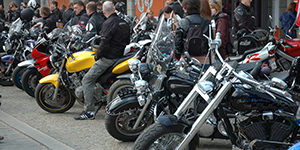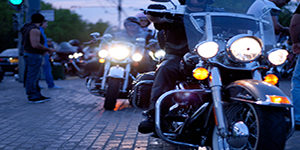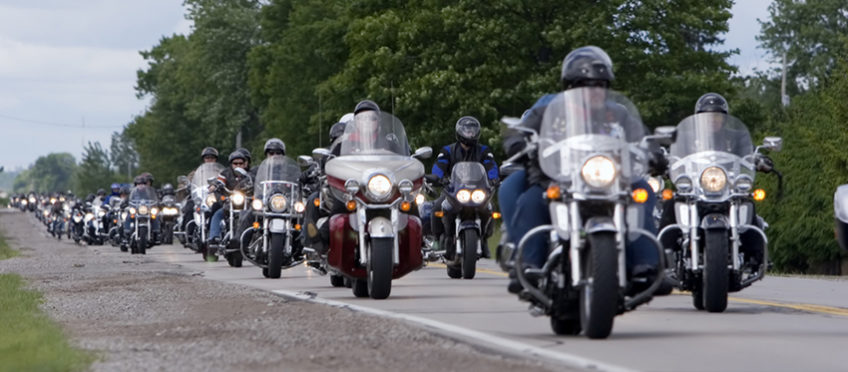Group riding has its attractions. It’s a great social outing with others who have similar interests. You have others to share experiences, the stuff that makes stories. Special friendships develop within groups. There’s also a sense of security when the unexpected happens.
But riding in close proximity with others, especially if you don’t know them, presents inherent risks.
Follow these tips to keep your group ride safe and enjoyable.
All Riders
Preparation
 1. Make sure you’re in the right frame of mind, physically, emotionally, and mentally alert and ready to ride.
1. Make sure you’re in the right frame of mind, physically, emotionally, and mentally alert and ready to ride.
2. Arrive on time and with a full tank of gas.
3. Be realistic about your riding skills and comfort with group rides, and stay within them.
4. Know and trust the riding habits, skill level, and dependability of fellow riders. It’s unwise to join an unorganized group where most riders are strangers. Not knowing how they’re going to react to mundane occurrences puts potentially everyone’s safety at risk.
5. Drop out, or agree to meet up at the next rest point, if at any time you’re uncomfortable with the riding habits of the group. Make sure to let others know you’re leaving.
6. Maintain a zero BAC (Blood Alcohol Content) during the ride.
Group Leaders
Organization
1. Begin with a riders’ meeting. Effective communication is key to a safe ride. Review how expectations for communication, guidelines for riding formation, and ground rules.
2. Assign lead and sweep riders to those with the most experience and willingness to accept the responsibility.
3. Identify group members certified in CPR and First Aid, just in case they’re needed.
4. Advise riders of the location of designated rest breaks and the final destination.
Ground Rules
1. Determine the signal to communicate if something is amiss — i.e. mechanical trouble or illness, and how that message will get to others in the group.
2. Establish the hand (or foot) signals for common occurrences, like road debris, moving to single file, and turns.
3. Confirm how fast the group will ride, relative to the speed limit. It seems ludicrous, but some groups will consistently well exceed the posted limit, and riders’ comfort levels.
4. Agree on how the group will manage fuel stops. Ten or twenty motorcycles pulling into a gas station at the same time creates a significant bottleneck. There are several alternatives for being efficient. Decide which works best for your group.
Formation Guidelines
 1. Ride in a staggered formation, beginning with the leader in the left tire track. Place weaker riders immediately behind the leader. If their riding creates a problem for the group, advise them to leave the group and meet up at the next rest stop.
1. Ride in a staggered formation, beginning with the leader in the left tire track. Place weaker riders immediately behind the leader. If their riding creates a problem for the group, advise them to leave the group and meet up at the next rest stop.
2. Maintain a two-second gap between you and the rider in front of you in the same tire track. Maintain a one-second distance with the rider in the opposite tire track.
3. Move over and up if a rider drops out.
4. Have each rider watch for the rider behind. Usually, the sweep rider will detect if anyone leaves the group, but it’s good to also watch out for each other. If you don’t see them, have a predetermined means of signaling the leader that someone is missing, then pull over and wait for them.
5. Stay in formation at all times, unless an unexpected situation requires you to move. Riding too close invites danger. Stringing out the group invites cars to cut in.
6. Do not pass within the group.
7. Pull up beside the adjacent rider at stops. Then, when leaving, resume the staggered formation.
8. Maintain an ideal group size of five to seven bikes. If there are more, break into subgroups, each with a lead and sweep rider.
9. Move into single file for turns, ramps, narrow streets, and curves. Once clear of these areas, return to staggered formation.
10. Wait to make sure all riders are present after making a turn.
11. Stop and accelerate slowly and smoothly, beginning with the leader. Jackrabbit starts cause a yo-yo effect in the group and can require those back in the pack to speed to catch up.
12. Maintain your passing speed until well beyond the slow vehicle while overtaking on a two-lane road. When returning to your lane, make sure there’s enough of a gap for the next rider to safely fall in behind. Don’t begin your pass until there’s a gap ahead of the slow vehicle for you to fit into.
13. Place bikes with loud exhausts at the back of the group. The rest of the group will thank you.
If you’re out riding and you’re not solo, you’re in a group. Whatever the group size, follow the tips to keep your ride safe and fun. Ride on!








join the conversation